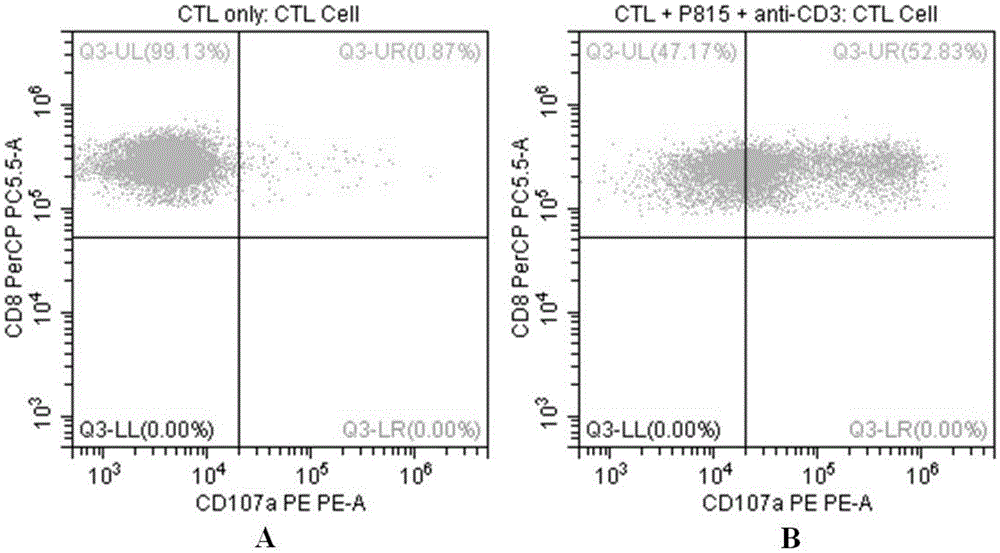Flow-cytometry detecting method of cytotoxic-T-lymphocyte degranulation
A technology of flow cytometry and cytotoxicity, which is applied in individual particle analysis, particle and sedimentation analysis, measuring devices, etc. It can solve the problems that the test results are easily affected by the subjective factors of the tester, the detection speed is slow, and the accuracy is poor. Achieve the effect of small influence of human factors, high accuracy and rapid detection
- Summary
- Abstract
- Description
- Claims
- Application Information
AI Technical Summary
Problems solved by technology
Method used
Image
Examples
Embodiment 1
[0046] A method for detecting cytotoxic T cell degranulation by flow cytometry, comprising the following steps:
[0047] S11. Separating the peripheral blood mononuclear cells in the sample to be tested and counting to adjust the cell concentration;
[0048] S12, taking the natural target cells of cytotoxic T cells and counting to adjust the cell concentration;
[0049]S13. Mix the peripheral blood mononuclear cells in step S11 and the cytotoxic T cell natural target cells in step S12 in equal proportions by volume and divide them into two groups, and add anti-human CD3 antibody to one of the groups As the experimental group, the other group as the control group; centrifuge the two groups after incubation and discard the supernatant to obtain a precipitate;
[0050] S14. Add flow staining buffer to resuspend the precipitate described in step S13, and add anti-CD3, CD8, D107a flow antibodies and incubate;
[0051] S15. After the incubation is completed, centrifuge, and wash t...
Embodiment 2
[0055] A method for detecting cytotoxic T cell degranulation by flow cytometry, comprising the following steps:
[0056] S21. Separating the peripheral blood mononuclear cells in the sample to be tested and counting to adjust the cell concentration to 1.8×10 6 / ml;
[0057] S22. Take P815 cells, the natural target cells of cytotoxic T cells, count and adjust the cell concentration to 1.8×10 6 / ml;
[0058] S23. Mix the peripheral blood mononuclear cells in step S21 and the cytotoxic T cell natural target cells in step S22 in equal proportions by volume and divide them into two groups, and add anti-human CD3 antibody to one of the groups As the experimental group (the concentration of the antibody is 0.25μg / 100μl), the other group is used as the control group; 2 After incubation in the incubator for 2.5 hours, centrifuge at 1200 rpm for 6 minutes, discard the supernatant, and obtain a precipitate;
[0059] S24. Add flow staining buffer to resuspend the precipitate described...
Embodiment 3
[0065] A method for detecting cytotoxic T cell degranulation by flow cytometry, comprising the following steps:
[0066] S31. Separating the peripheral blood mononuclear cells in the sample to be tested and counting to adjust the cell concentration to 2.2×10 6 / ml;
[0067] S32. Take P815 cells, the natural target cells of cytotoxic T cells, count and adjust the cell concentration to 2.2×10 6 / ml;
[0068] S33. The peripheral blood mononuclear cells in step S31 and the cytotoxic T cell natural target cells in step S32 are mixed in equal proportion by volume and divided into two groups on average, and anti-human CD3 antibody is added to one of the groups As the experimental group (the concentration of the antibody is 0.5μg / 100μl), the other group is used as the control group; 2 After incubation in the incubator for 3.5 hours, centrifuge at 1600 rpm for 4 minutes, discard the supernatant, and obtain a precipitate;
[0069] S34. Add flow staining buffer to resuspend the preci...
PUM
| Property | Measurement | Unit |
|---|---|---|
| Antibody concentration | aaaaa | aaaaa |
Abstract
Description
Claims
Application Information
 Login to View More
Login to View More - Generate Ideas
- Intellectual Property
- Life Sciences
- Materials
- Tech Scout
- Unparalleled Data Quality
- Higher Quality Content
- 60% Fewer Hallucinations
Browse by: Latest US Patents, China's latest patents, Technical Efficacy Thesaurus, Application Domain, Technology Topic, Popular Technical Reports.
© 2025 PatSnap. All rights reserved.Legal|Privacy policy|Modern Slavery Act Transparency Statement|Sitemap|About US| Contact US: help@patsnap.com


